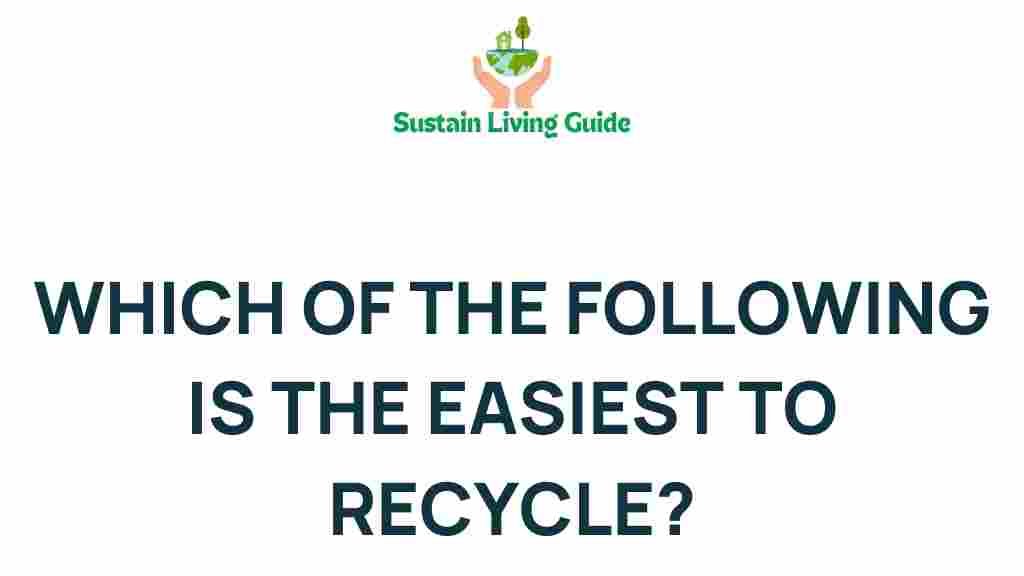Unveiling the Easiest Recyclables: What Can You Toss in the Bin?
Recycling is an essential practice that helps protect our environment, conserve natural resources, and reduce landfill waste. However, many people are often confused about what can actually be recycled and what should be thrown in the trash. This comprehensive guide will unveil the easiest recyclables, clarify recycling symbols, and provide useful tips to ensure you’re recycling the right items. Whether you’re new to recycling or looking to enhance your knowledge, this article will serve as a valuable resource.
Understanding Recycling
Recycling is the process of converting waste materials into reusable materials. This process not only helps reduce the amount of waste sent to landfills but also conserves energy and natural resources. By recycling, you play a crucial role in fostering a sustainable environment for future generations.
Why Recycling Matters
Here are a few reasons why recycling is important:
- Conserves Natural Resources: Recycling reduces the need for raw materials, thus preserving forests, water, and minerals.
- Reduces Pollution: Fewer raw materials mean less pollution from extraction and processing.
- Saves Energy: Recycling often uses less energy compared to producing new products from raw materials.
- Supports the Economy: Recycling creates jobs in various sectors, from collection to processing and manufacturing.
What Can You Toss in the Recycling Bin?
Knowing what can be recycled is crucial for effective recycling. Here’s a detailed breakdown of common recyclables based on material type.
1. Paper Products
Most paper products can be recycled, including:
- Office paper
- Newspapers
- Cardboard (flattened)
- Magazines
- Phone books
Tip: Make sure to remove any plastic windows from envelopes and avoid recycling paper that is heavily contaminated with food or grease, like pizza boxes.
2. Plastics
Plastic recycling can be a bit tricky due to the variety of plastics. Here are the most commonly accepted types:
- Plastic bottles (e.g., water, soda, milk)
- Containers (e.g., yogurt, margarine)
- Plastic bags (check local regulations)
Note: Look for recycling symbols on the bottom of containers. The most widely accepted are types 1 (PETE) and 2 (HDPE).
3. Metals
Both aluminum and steel are highly recyclable:
- Aluminum cans (e.g., soda, beer)
- Steel cans (e.g., food cans)
Make sure to rinse out containers before tossing them in the recycling bin to avoid contamination.
4. Glass
Glass is another material that can be recycled multiple times without losing quality:
- Glass bottles (e.g., wine, beer, soda)
- Glass jars (e.g., food jars)
Warning: Avoid recycling glass that is broken, as it can pose safety risks and additional costs to recycling facilities.
5. Electronics
While not typically accepted in curbside recycling, many communities offer electronic recycling programs. Items that can often be recycled include:
- Old computers
- Smartphones
- Televisions
- Printers
Check with your local waste management for proper disposal locations.
How to Recycle Effectively
Recycling can sometimes feel overwhelming, but following a few simple steps can make the process easier:
Step 1: Know Your Local Guidelines
Each municipality may have different recycling rules. Check your local waste management website for specific guidelines on what can and cannot be recycled. Understanding these rules ensures that you are correctly sorting your recyclables.
Step 2: Clean Your Recyclables
Contamination is one of the largest challenges facing recycling programs. Rinse out any food or beverage containers to keep them clean. A simple rinse can go a long way in preventing contamination.
Step 3: Sort Your Materials
Separate recyclables from regular trash. Use designated bins for different materials (paper, plastics, metals, and glass) if your local program requires it.
Step 4: Flatten Cardboard
Flatten cardboard boxes to save space in your recycling bin and ensure they fit into collection trucks efficiently.
Step 5: Stay Informed
Stay updated on any changes in local recycling policies, as regulations can change based on market conditions. Follow local news or community boards for updates.
Troubleshooting Common Recycling Issues
Recycling can sometimes lead to confusion or frustration. Here are some troubleshooting tips for common recycling issues:
Problem: My recyclables aren’t being picked up.
Solution: Check if you’re following local guidelines and ensure your recyclables are clean and sorted correctly. If everything seems fine, contact your local waste management for clarification.
Problem: I’m unsure if an item is recyclable.
Solution: When in doubt, refer to your local recycling guidelines or check recycling symbol resources for clarification.
Problem: My recycling bin is overflowing.
Solution: If your recycling bin is consistently full, consider reducing your waste or contacting your local waste management to see if you can obtain an additional bin.
Problem: I accidentally mixed recyclables with trash.
Solution: It happens! Just be mindful in the future. Take the time to sort your items correctly to avoid contamination.
Conclusion
Recycling is a simple yet powerful way to make a positive impact on our environment. By understanding what can be tossed in the recycling bin and following best practices, you can contribute to a cleaner, greener planet. Remember, the key to successful recycling lies in knowledge and commitment. Join the movement towards sustainability and encourage others to do the same. Together, we can make recycling a part of our everyday lives. For more information on recycling practices, check out this recycling guide.
This article is in the category Waste and created by SustainLivingGuide Team

1 thought on “Unveiling the Easiest Recyclables: What Can You Toss in the Bin?”